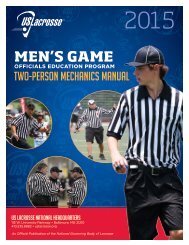BASKETBALL
You also want an ePaper? Increase the reach of your titles
YUMPU automatically turns print PDFs into web optimized ePapers that Google loves.
52<br />
Rule 4 / Definitions<br />
Art. 6. When a player approaches an opponent from behind or a position from<br />
which the player has no reasonable chance to play the ball without making<br />
contact with the opponent, the responsibility for contact shall be that of the player<br />
in the unfavorable position.<br />
Section 22. Jump Stop<br />
Art. 1. A jump stop is executed when a player catches the ball while moving or<br />
dribbling with:<br />
a. One foot on the playing court, jumps off that foot and lands simultaneously<br />
on both feet (no pivot foot).<br />
b. Two feet off the playing court, lands on one foot, jumps off that foot and<br />
lands simultaneously on both feet (no pivot foot).<br />
Art. 2. A jump stop may also be executed when the dribbler has one foot on<br />
the playing court, initiates a jump off that foot, ends the dribble with both feet<br />
off the playing court and lands simultaneously on both feet (either foot can be<br />
established as the pivot foot).<br />
Section 23. Location of a Player<br />
Art. 1. The location of a player (or non-player) is determined as being:<br />
a. Where he is touching the floor, as far as being inbounds or out of bounds.<br />
b. In the front court or back court.<br />
c. Outside the three-point line with at least one foot in contact with the<br />
playing floor behind the line before the release of the try and the other foot<br />
not contacting the line or the playing floor in front of the line.<br />
Art. 2. When a player is in the air from a leap (except during a throw-in) or<br />
when a defensive player intercepts a ball while in the air, the player’s status with<br />
reference to these two situations shall be the same as at the time the player was<br />
last in contact with the floor or an extension of the floor, such as a bleacher.<br />
Art. 3. When the ball touches an official or a player who is on the playing court,<br />
play shall continue as if the ball touched the floor at that individual’s location.<br />
Section 24. Pass<br />
A pass is movement of the ball caused by a player who throws, bats or rolls the<br />
ball to another player. In order for a pass to be completed, the ball shall touch<br />
another player.<br />
Section 25. Penalty<br />
Art. 1. A penalty for a foul is the charging of the offender with the foul and/or<br />
awarding one or more free throws, and/or awarding the ball to the opponent for<br />
a throw-in. For any flagrant 2 foul, the penalty includes ejection of the offender.<br />
Art. 2. The penalty for a violation is the awarding of the ball to the opponent for<br />
a throw-in, one or more points or a substitute free throw.<br />
Section 26. Pivot<br />
A pivot takes place when a player who is holding the ball steps once or more than<br />
once in any direction with the same foot, while the other foot, called the pivot<br />
foot, is kept at its point of contact with the playing court.




